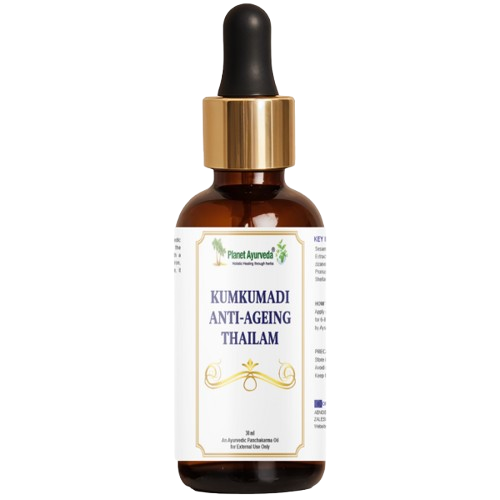Kumkumadi Anti-ageing Thailam – Key Ingredients, Their Benefits, Indications & Panchakarma Uses
Introduction
Radiance is the essence of beauty, and nothing nourishes the skin like the time-tested wisdom of Ayurveda. Kumkumadi Anti-ageing Thailam from Planet Ayurveda is a luxurious herbal formulation celebrated for centuries for its transformative effects on the skin. Enriched with a blend of potent Ayurvedic herbs, this oil rejuvenates, nourishes, and restores the natural glow of the skin. It not only reduces pigmentation, dark spots, and blemishes but also promotes even skin tone, softness, and vitality. Known as the “elixir for glowing skin,” Kumkumadi Anti-ageing Thailam combines the ancient secrets of Kesar (Crocus sativus), Patranga (Caesalpinia sappan), Ushira (Vetiveria zizanioidis) and a host of other rejuvenating herbs, delivering deep nourishment while maintaining the skin’s natural balance. Planet Ayurveda’s Kumkumadi Anti-ageing Thailam is a perfect harmony of tradition and purity, crafted to give your skin the youthful radiance it deserves.
Ingredients
Planet Ayurveda’s Kumkumadi Anti-ageing Thailam contains following ingredients –
1. Kumkum (Crocus sativus)
Saffron/Kesar/Kumkum (Crocus sativus) is Katu (Pungent) and Tikta (Bitter) in taste, Ushna (Hot) in potency and balances Tridoshas (Vata, Pitta and Kapha). It acts as Raktaprasadak (Blood Tissue Cleanser) and Varnya (Improves skin complexion). It contains volatile oil rich in Terpenes, Terpene alcohols and esters. Other than this, it also contains Crocin, Crocetin, Carotenoids and Thiamine. Saffron (Crocus sativus) possess antiseptic, soothing and moisturising properties, making it ideal for sensitive and dry skin. Its anti-inflammatory action helps in reducing redness and it also improves smoothness and suppleness of the skin.
2. Patranga (Caesalpinia sappan)
It is called ‘Bakam’ in Hindi and ‘Sappanwood’ in English. It is Kashaya (Astringent), Tikta (Bitter) and Madhura (Sweet) in taste, Sheeta (Cold) in potency and balances Pitta and Kapha doshas in our body. Its main chemical composition is Brazilin, Brazilian, Tannins and Volatile oils. It has remarkable skin enhancing properties as well as is a strong antibacterial and antifungal herb. It improves Varna (skin tone) by enhancing microcirculation and removing toxins.
3. Ushira (Vetiveria zizanioides)
Widely popular as ‘Khaskhas Grass’ in India, it is Madhur (Sweet) and Tikta (Bitter) in taste and is Sheeta (Cold) in potency. Being a natural coolant, it is highly beneficial in treating inflamed skin and soothes it very quickly. It contains chemical constituents like Allukhisiol, Benzoic acid, Eugenol, Vetivene, Vanillin etc. Other than soothing irritated skin, it also hydrates skin, reduces acne and improves skin elasticity.
4. Manjishtha (Rubia cordifolia)
Popularly known as Indian Madder, it is Tikta (Bitter), Kashaya (Astringent) and Madhur (Sweet) in taste. It pacifies Pitta and Kapha doshas and is also Kushtaghan (Relieving skin conditions) in action. It contains active constituents like Manjistin, Purpurin, Xanthopurpurin etc. Manjishtha (Rubia cordifolia) is Raktashodhak (purifies blood tissue) and Varnya (Improving skin complexion), and also protects skin from oxidative damage.
5. Padmaka (Prunus cerasoides)
It is called ‘Bird Cherry’ and ‘Wild Himalayan Cherry’ in English, and is Tikta (Bitter) and Kashaya (Astringent) in taste. It balances Pitta and Kapha doshas and is of Sheeta (Cold) potency, so is useful in Pitta-aggravated skin conditions. It contains active constituents like Puddumin, B-sitosterol, Ursolic Acid etc. which are anti-inflammatory and anti-septic in action. They also support collagen synthesis, which tightens skin, reduces fine lines and protects against UV-induced damage.
6. Kamal (Nelumbo nucifera)
The Lotus/Kamal (Nelumbo nucifera) holds profound spiritual, cultural, and symbolic importance in India, representing purity, enlightenment, and divine beauty. According to Ayurveda, it is Kashaya (Astringent), Madhura (Sweet) and Tikta (Pungent) in taste, Sheeta (Cold) in potency and it pacifies Pitta and Kapha doshas. The chemical constituents like Robinin, Nuciferine, Neferine, oleic acid etc. present in this makes it effective in enhancing collagen integrity and also regulates sebum. Moreover, it suppresses melanin synthesis and even skin tone, giving a natural brightness.
7. Laksha (Laccifer lacca)
Commonly known as Lac Resin in English (since its Resin is used for therapeutic purposes), it is Kashaya (Astringent) in taste, Sheeta (Cold) in potency and is Snigdha (Unctuous) as well. Purified Laksha (Laccifer lacca) has many health benefits, one of them is improving skin complexion. It balances Pitta and Kapha doshas and has active constituents like Lacconic acid, Erythrolaccin, Resinoltannols of aleuritic acid etc. It accelerates tissue regeneration, nourishes deeper skin tissues, delays wrinkles and brings a natural glow due to its blood-purifying effect.
8. Daruhaldi (Berberis aristata)
It is called ‘Indian Barberry’ in English, and is Tikta (Bitter) and Kashaya (Astringent) in taste. It balances Pitta and Kapha doshas in the body and works as Shothara (Reduces inflammation), Vranashodhak (Wound purifying) and Raktashodhak (Cleanses Blood Tissue). It contains chemical constituents like Berberine, Alkaloids etc. and they have anti-inflammatory and anti-oxidant properties, making it extremely beneficial for irritated skin.
9. Nagkesar (Mesua ferrea)
It is also called ‘Cobra’s Saffron’ and contains Tikta (Bitter) and Kashaya (Astringent) taste. It pacifies Pitta and Kapha doshas and is Kushthaghana (Relieves skin conditions) in action. It contains Mesuol, Mesuaferrone, Mammeisin, Mesuagin etc. and they enhance microcirculation, detoxify skin tissues, and protect from UV-induced oxidative damage, making it useful in combating pigmentation, dullness and premature ageing.
10. Kusum Phool (Carthamus tinctorius)
The Safflower/Dyers Saffron/Kusumb (Carthamus tinctorius) is Katu (Pungent) in taste and Ushna (Hot) in potency. It has chemical constituents like Carthamone, Lignans, Sesquiterpene glycoside etc. which helps soothe inflamed skin, neutralizes free radicals, improves blood flow to skin tissues and supports ceramide synthesis, improving skin barrier integrity and moisture retention.
11. Priyangu (Callicarpa macrophylla)
As its English name—‘Beauty Berry’—suggests, it is often used in Ayurveda due to its Kantivardhak (Complexion enhancer) and Raktashodhak (Blood purifying) properties. It is Madhura (Sweet), Kashaya (Astringent) and Tikta (Bitter) in taste, Sheeta (Cold) in potency and is Tridosha-shamak (balances Vata, Pitta and Kapha). It possesses active constituents like Calliterpenone, Crategolic acid, B-sitosterol etc. and they exhibit strong antibacterial action and provide relief in erythema, sun-related irritations making it especially suitable for Pitta-dominant skin types.
12. Vat (Ficus bengalensis)
In English it is called ‘Banyan Tree’. It is Kashaya (Astringent) in taste, Sheeta (Cold) in potency and balances Pitta and Kapha doshas. It contains active constituents like Phytosterols, Triterpin, B-sitosterol, Bengalinoside etc. It plays a key role in maintaining cell membrane stability, moisture retention and skin elasticity, making it suitable for dry skin.
13. Madhu Malti (Hiptage benghalensis)
Often called ‘Madhavi Lata’ in Hindi and ‘Helicopter Flower’ in English, it is Madhura (Sweet), Katu (Pungent), Tikta (Bitter) and Kashaya (Astringent) in taste, Sheeta (Cold) in potency and balances all three doshas (Vata, Pitta and Kapha). It is rich in Flavonoids, Tannins, Alkaloids, Phenols etc. making it useful in preventing the recurrence of acne, boils and other inflammatory skin eruptions. It also helps in removing impurities and excess oil from skin pores, giving a clean and refreshed appearance.
14. Beeswax (Cera alba)
It is used for cosmetic and therapeutic purposes in Ayurveda. It is called Madhuchista i.e. leftover product that remains after honey extraction. It contains Palmitate, Palmotoleate, Acid esters etc. so it is considered as a natural emollient. It is Snigdha (Unctuous), Mridu (Softening) in action and Sheeta (Cold) in potency. It is Pitta and Kapha pacifying and is excellent for maintaining skin softness, moisture and natural lustre.
15. Sarshapa (Brassica juncea)
Often called ‘Rai’ in Indian households, it is Katu (Pungent) in taste, Ushna (Hot) in potency and balances Kapha and Vata doshas. Its seeds contain Rutin and Arabinogalactan which improve skin’s defence against UV-induced damage by stabilising collagen and elastin fibres and inhibiting Matrix Metallo Proteinases (MMP’s) that degrade skin texture.
16. Rasna (Pluchea lanceolata)
This herb is Tikta (Bitter) in taste and vitiates Vata and Kapha doshas. It contains chemical constituents like Moretenol, Stigmasterol, B-sitosterol, Pluchin etc. It provides strong relief in inflammatory skin diseases and also reduces transepidermal water loss, maintaining the moisture in skin. It protects dermal cells from oxidative injury and prevents photoaging, pigmentation, and collagen breakdown as well.
17. Payas (Pueraria tuberosa)
It is known as ‘Vidarikanda’ in Ayurveda, and is Madhura (Sweet) in taste, Sheeta (Cold) in potency and balances Vata and Pitta doshas. It contains active constituents like B-sitosterol, Puerarin, Stigtmasterol etc. It exhibits potent phytoestrogenic and antioxidant activity that supports skin rejuvenation and also suppresses melanogenesis, helping in hyperpigmentation disorders. It acts as a Twak poshak dravya (skin-nourishing agent) and Rakta-shodhak (blood purifier), restoring glow and complexion.
18. Dashmoola (Roots of 10 Herbs)
Dashamoola includes roots of Bilva (Aegle marmelos), Agnimantha (Premna integrifolia), Shyonaka (Oroxylum indicum), Gambhari (Gmelina arborea), Patala (Stereospermum suaveolens), Shalaparni (Desmodium gangeticum), Prishniparni (Uraria picta), Brihati (Solanum indicum), Kantakari (Solanum xanthocarpum) and Gokshura (Tribulus terrestris). It is Tridoshahara (balances Vata, Pitta and Kapha) and most of these herbs have Ushna (Hot) potency. It promotes healing of skin tissue, reduces inflammation and enhances skin resilience. It improves skin cell nourishment, promoting vitality and firmness.
19. Til Oil (Sesamum indicum)
It is Madhur (Sweet) in taste, Tikta (Bitter) and Kashaya (Astringent) in Anurasa (Aftertaste), and Ushna (Hot) in potency. This oil is used as a carrier oil in traditional Ayurvedic oils due to its Sukshamata (Penetrating qualities), since it carries the medicinal herbs deep into the tissues. It is Snigdha (Unctuous) and Ushna (Hot), making it an excellent choice for balancing Vata. Its oxidative stability helps in preserving therapeutic properties of the herbs and it is rich in chemical constituents like Linoleic acid, Sesamol, Sesamin, Vitamin E, which helps in maintaining skin moisture, elasticity and glow.
Benefits
- Balance doshas in the skin
- Improves complexion and radiance
- Improves skin elasticity
- Reduces pigmentation and dark spots
- Fights acne and pimples
- Reduces fine lines and wrinkles
- Heals scars and marks
- Provides deep moisturisation
- Brightens under-eye dark circles
- Enhances skin resilience
Ideal For (Indications)
- Uneven skin tone and complexion
- Melasma
- Sun-tan
- Post-inflammatory hyperpigmentation
- Acne, Pimples and Blemishes
- Premature ageing
- Dry and rough skin
- Dark-circles
- Sensitive and irritated skin
Usage
It is to be applied on a clean and dry face. Gently massage 10-15 drops of Kumkumadi Anti-ageing Thailam into the skin and leave it overnight for best results. Please note, it is for local application only and kindly do a patch test before using it.
To buy Kumkumadi Anti-ageing Thailam, please visit store.planetayurveda.com/products/kumkumadi-anti-ageing-thailam
Conclusion
Planet Ayurveda’s Kumkumadi Anti-ageing Thailam is a timeless Ayurvedic formulation that harnesses the potent synergy of traditional herbs to nourish, rejuvenate, and enhance skin radiance. With its unique blend of ingredients like Kesar (Crocus sativus), Manjishtha (Rubia cordifolia), and other rejuvenating herbs, it not only improves complexion but also addresses pigmentation, blemishes, and signs of premature ageing. Enriched with a natural carrier like Til Oil (Sesamum indicum), this oil penetrates deeply, providing intense moisturisation, soothing inflamed skin, and restoring vitality. Ideal for all skin types, including sensitive and dry skin, Kumkumadi Anti-ageing Thailam represents the perfect harmony of ancient wisdom and modern skin care needs. Regular use promotes a youthful, glowing, and even-toned complexion, making it an essential elixir for radiant skin.




